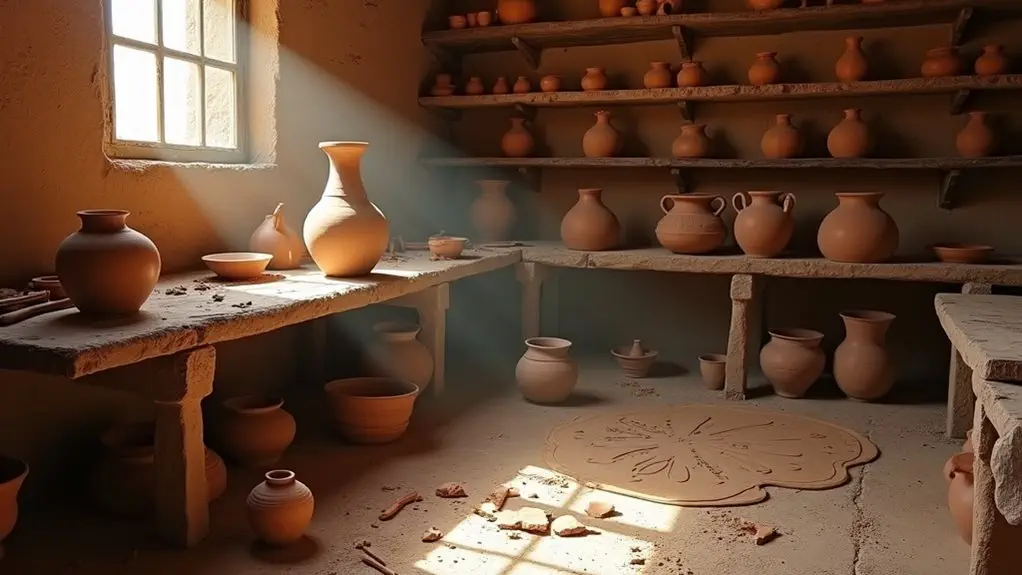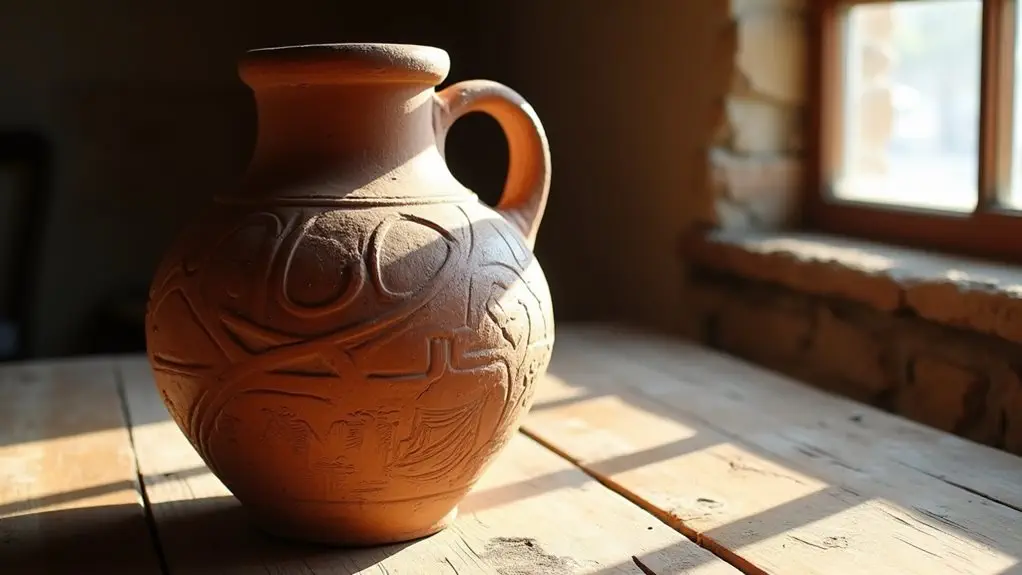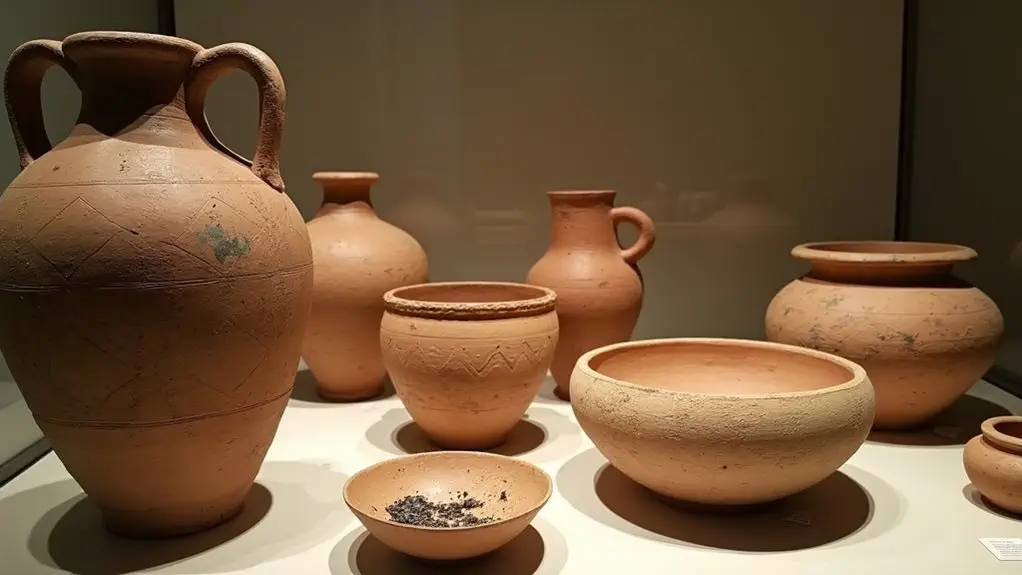Ancient pottery is like a time capsule that tells you incredible stories about past civilizations. You'll discover how people lived, traded, and expressed themselves through these clay vessels. From simple cooking pots to elaborate ceremonial pieces, pottery reveals daily routines, cultural practices, and even long-forgotten trade routes. Scientists can analyze clay compositions to track where vessels originated, while artistic decorations show what people valued and believed. Every pottery shard holds clues about ancient technologies, from basic hand-building to advanced wheel-throwing techniques. There's a whole world of human history waiting to be uncovered in these remarkable ceramic treasures.
The Ancient Potter's Workshop

How did ancient civilizations transform simple clay into magnificent works of art? You'd find the answer in the bustling workshops of ancient potters, where skilled artisans turned humble earth into vessels of both beauty and function.
In these workshops, you'd see potters using an array of fascinating techniques. They'd start by carefully preparing their clay through levigation, mixing it with water to remove pesky twigs and rocks – kind of like straining pasta, but with mud! These ancient techniques have been preserved through modern pottery workshops that continue teaching traditional methods today.
Some craftsmen preferred the meditative process of hand-building, pinching and coiling clay into shape with their fingers. Others would sit at their wheels, transforming spinning lumps of clay into perfectly symmetrical bowls and vases.
Once shaped, the pottery wasn't finished yet. You'd watch as artisans carefully dried their creations to a leather-hard state before the big show – the firing process.
In their three-stage firing methods, they'd transform soft clay into durable ceramics. It's amazing to think that these ancient workshops weren't just producing pots; they were preserving their culture, advancing technology, and creating economic networks that we're still learning from today.
Trade Routes Through Clay
If you could piece together ancient pottery shards like a jigsaw puzzle, you'd reveal a vast network of trade routes that crisscrossed the ancient world. From the bustling Silk Road to the maritime highways of the Mediterranean, pottery has left us countless clues about how our ancestors connected and traded with one another.
You might be surprised to learn that those broken pieces of clay you'd find at an archaeological site can tell you more than just where people traded – they're like ancient receipts of cultural exchange! When archaeologists study these fragments, they're not just looking at pretty decorations. They're using sophisticated methods like trace-element analysis to figure out where the pottery came from and what it once contained. These pieces often served as economic currency in ancient civilizations, making them valuable tools for understanding past trading systems.
Think of pottery as the ancient world's shipping containers. Whether it was carrying wine across the Mediterranean or spices along the Amber Road, each piece tells a story of commerce and connection.
Even the way the pottery was made can reveal trade secrets – literally! Different crafting techniques spread from region to region, showing us how ancient cultures shared their knowledge and artistic styles, much like we share recipes and fashion trends today.
Daily Life in Pottery

Through the eyes of ancient pottery, we can glimpse the rhythm of daily life thousands of years ago. You'll find that these clay vessels weren't just decorative pieces – they were the ancient equivalent of our modern kitchen containers, cooking pots, and storage solutions.
When you picture an ancient Egyptian home, you'd see clay pots filled with grains and oils, much like your own pantry today. You might be surprised to learn how versatile pottery was in daily life. Whether you needed to store wine for a celebration, transport water from the well, or cook your family's dinner, there was a pot for that! Trade and commerce flourished as pottery became a valuable commodity between ancient civilizations.
The ways these vessels were made evolved too – from simple hand-building methods to the game-changing potter's wheel, which made creating uniform pots much easier. It's fascinating to think that when you look at ancient pottery, you're seeing someone's actual kitchen tools or ceremonial vessels.
These weren't just containers; they were the building blocks of daily life, telling stories of meals shared, rituals performed, and communities connected through the simple yet essential art of pottery-making.
Scientific Secrets Within Ceramics
While ancient pottery tells stories through its shapes and designs, modern science reveals even deeper secrets hidden within these ceramic treasures. You'd be amazed at how scientists can uncover everything from trade routes to cooking habits just by examining tiny fragments under a microscope!
When archaeologists study pottery today, they're like detectives with high-tech tools. They'll use thermoluminescence tests to figure out when a pot was fired (it's basically like checking a ceramic's birth certificate), and they'll analyze trace elements to pinpoint exactly where the clay came from. Today's researchers are even incorporating graphene oxide reinforcement to better understand ancient ceramic durability.
You can't fool these scientists – they'll know if that pot was made locally or imported from hundreds of miles away!
Through ceramic petrography and X-ray analysis, we're learning secrets that ancient potters never imagined we'd discover. Scientists can tell you what temperature the pottery was fired at, what minerals were mixed into the clay, and even what foods or liquids were stored inside.
It's fascinating how a simple pot can tell us so much about how our ancestors lived, traded, and developed their technology – all thanks to modern scientific methods.
Cultural Practices and Traditions

A single clay pot can hold centuries of cultural wisdom within its walls. When you look closely at pottery from different cultures, you'll discover it's not just about making containers – it's about preserving stories, beliefs, and traditions that have been passed down through generations.
The glazing techniques developed throughout history transformed pottery from simple clay vessels into works of art. You'll find this especially true in Native American communities, where Pueblo potters use traditional coil-and-scrape techniques to create vessels that tell stories through their designs.
In West Africa, Yoruba pottery isn't just beautiful – it's packed with symbolic meanings that reflect their cultural values. If you're examining Islamic pottery from the Middle East, you'll notice the stunning geometric patterns and calligraphy that showcase their artistic traditions.
What's fascinating is how pottery helps you peek into ancient people's daily lives and spiritual practices.
Take the Mississippian culture, where they created special effigy pots for ceremonies, or the Moche in South America, who literally painted their daily activities and beliefs onto their ceramics. It's like these ancient artists left us a detailed diary – except instead of words, they used clay to tell their stories.
Final Thoughts
Isn't it amazing how a simple clay pot can reveal thousands of years of human history? You've seen how pottery serves as a time capsule, revealing ancient trade networks, daily routines, and cultural traditions. From the potter's fingerprints to the chemical makeup of clay, these ceramic treasures continue to share their stories. So next time you're holding a piece of pottery, remember: you're touching a direct connection to our ancestors' lives.




